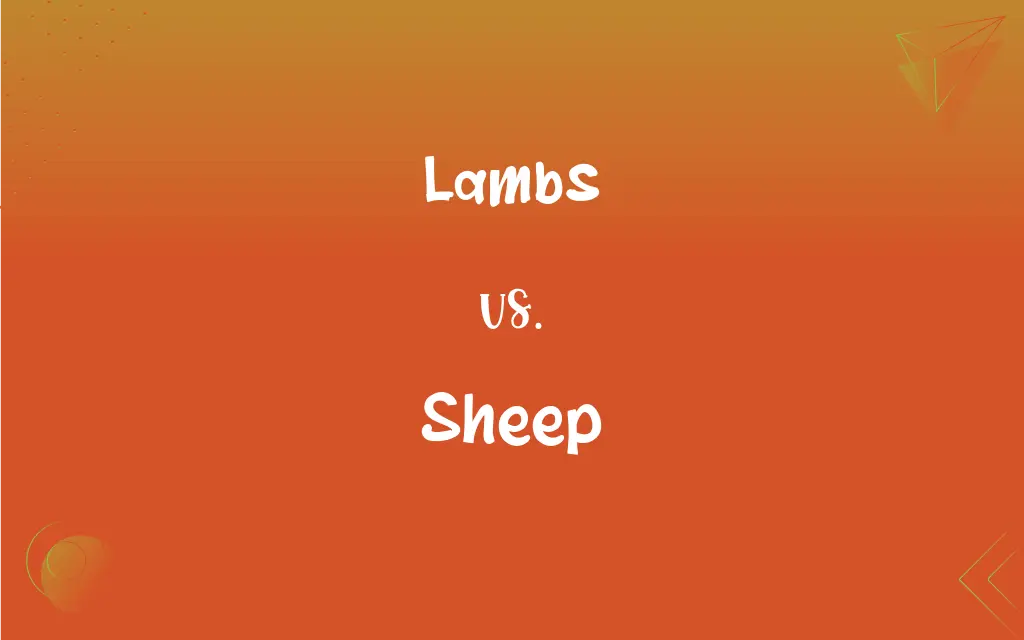Lambs vs. Sheep: What's the Difference?
Edited by Janet White || By Harlon Moss || Updated on June 26, 2024
Lambs are young sheep, typically less than one year old. Sheep refers to the species as a whole, encompassing all ages.

Key Differences
Lambs denote the young offspring of sheep, usually signifying those that are less than one year old. In contrast, the term sheep refers to the animal species as a whole, inclusive of all ages, and is used to describe both the young and adult animals.
Lambs are often associated with certain characteristics like being smaller, fluffier, and more playful, embodying juvenile traits. On the other hand, sheep, as a broad term, encapsulates various stages of life from the playful lamb, through adolescence, to a fully grown, often wool-laden animal.
Lambs, particularly in a cultural or symbolic context, often embody symbols of innocence and gentleness. Sheep, however, have a wider symbolic range, often being associated with docility, following, and also with abundance or prosperity, due to their wool and meat.
Lambs are primarily known for their tender meat in culinary contexts, which is a delicacy in many cuisines worldwide. In contrast, sheep are recognized not only for their meat but also for their wool, which is sheared from adults to produce textiles.
Lambs are traditionally more safeguarded and cared for due to their young age and vulnerability. Sheep, being the overarching category, comprise diverse care routines, protective measures, and herding practices depending on their role in production, whether it be for meat, wool, or breeding.
ADVERTISEMENT
Comparison Chart
Definition
Young offspring of sheep, under one year
The species as a whole, including all ages
Symbolism
Often symbolizes innocence and gentleness
Can symbolize docility, prosperity, or abundance
Culinary Usage
Known for tender meat
Known for meat and occasionally milk
Economic Value
Primarily valued for meat
Valued for meat, wool, and breeding
Care
Require protective care due to vulnerability
Diverse care routines depending on purpose (meat, wool, breeding)
ADVERTISEMENT
Lambs and Sheep Definitions
Lambs
Lambs are characterized by their soft, woolly coats.
The lambs' fluffy coats looked exceptionally soft.
Sheep
Sheep can be found in various breeds, each with distinct characteristics.
The farmer bred a particular type of sheep for its fine wool.
Lambs
Lambs are often symbolically associated with innocence.
The painting depicted lambs as emblems of purity.
Sheep
Sheep are a domesticated ruminant mammal with dense wool.
The sheep were sheared to obtain wool for knitting.
Lambs
Lambs are known for their particularly tender meat.
The chef prepared a dish featuring succulent lambs' meat.
Sheep
Sheep have been utilized historically for meat, wool, and skin.
Ancient civilizations utilized sheep for a variety of resources.
Lambs
Lambs are the young of sheep, typically under a year old.
The lambs frolicked playfully in the meadow.
Sheep
Sheep often graze in flocks and are herded by shepherds.
The shepherd led the flock of sheep across the hills.
Lambs
Lambs can be of various breeds, affecting their size and coat.
The farmer introduced a few new breeds of lambs to the flock.
Sheep
Sheep, when referred to collectively, are called a flock.
The flock of sheep moved gracefully through the pasture.
Lambs
A young sheep, especially one that is not yet weaned.
Sheep
A domesticated ruminant mammal (Ovis aries) having a thick coat, raised in many breeds for its wool, edible flesh, or hide.
Lambs
The flesh of a young sheep used as meat.
Sheep
Any of various wild ruminant mammals related to and resembling the domestic sheep, such as the aoudad, bighorn sheep, and mouflon.
Lambs
Lambskin.
Sheep
Leather made from the skin of one of these animals.
Lambs
A sweet, mild-mannered person; a dear.
FAQs
Why is wool primarily sheared from adult sheep and not lambs?
Adult sheep have more wool and it's often thicker and longer than that of lambs.
Are all lambs female?
No, lambs can be male or female; the term refers to young sheep of either sex.
Do all sheep produce wool?
While most sheep breeds do produce wool, some produce hair instead.
Are all sheep herded with the use of sheepdogs?
While sheepdogs are common, herding practices can vary; some use shepherds, others use horses or ATVs, and some sheep are allowed to graze freely.
What is the primary difference between lambs and sheep?
Lambs are young sheep, typically under one year old, while "sheep" refers to the species as a whole.
How do lambs recognize their mothers?
Lambs recognize their mothers through scent and vocalizations soon after birth.
Can all sheep breeds interbreed?
While different sheep breeds can interbreed, specific breeding practices are usually maintained to preserve breed characteristics.
Is lamb meat and sheep meat the same?
Lamb meat comes from young sheep, and is generally more tender; mutton comes from older sheep.
Are all sheep white?
No, sheep can come in various colors, including black, brown, and gray, depending on the breed.
What is the lifespan of lambs and sheep?
Lambs are young sheep under one year, while adult sheep typically live to be 6-12 years old, depending on breed and conditions.
When is a lamb typically weaned?
Lambs are usually weaned at around 2 to 4 months of age, depending on breed and individual circumstances.
What is the primary economic value of sheep?
Sheep provide various products such as meat, wool, and milk, offering diverse economic value.
Can both male and female sheep have horns?
Yes, depending on the breed, both ewes (females) and rams (males) can have horns.
Are lambs born with a full coat of wool?
Lambs are born with a light coat of wool, which continues to grow and thicken as they age.
Why are sheep often associated with pastoral scenes?
Sheep have historically been pastoral animals, often grazed in rural settings, which establishes them as a symbol of pastoral life.
Are lambs seasonal breeders?
Yes, sheep are typically seasonal breeders, with most lambs being born in spring.
What do lambs eat?
Lambs initially drink their mother's milk and gradually shift to solid food like grass, hay, and pellets as they grow.
Are sheep raised worldwide?
Yes, sheep are raised on every continent, with China, Australia, and New Zealand being among the largest producers.
How long is a sheep’s gestation period?
The average gestation period for a sheep is approximately 147 days.
Is "sheep" the correct term for multiple animals of the species?
Yes, "sheep" is correct for referring to one or more animals of the species.
About Author
Written by
Harlon MossHarlon is a seasoned quality moderator and accomplished content writer for Difference Wiki. An alumnus of the prestigious University of California, he earned his degree in Computer Science. Leveraging his academic background, Harlon brings a meticulous and informed perspective to his work, ensuring content accuracy and excellence.
Edited by
Janet WhiteJanet White has been an esteemed writer and blogger for Difference Wiki. Holding a Master's degree in Science and Medical Journalism from the prestigious Boston University, she has consistently demonstrated her expertise and passion for her field. When she's not immersed in her work, Janet relishes her time exercising, delving into a good book, and cherishing moments with friends and family.































































